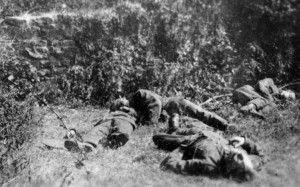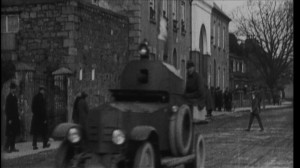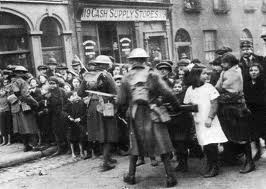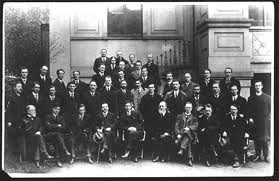Today in Irish History, The Truce, 11 July 1921
By John Dorney. The last day of the Irish War of Independence
On the 9 July 1921, a ‘Dublin boy’, Paddy O’Connor made his way to the hills around Donohill,South Tipperary, looking for Mrs Quirke’s house. In fact his youthful appearance was deceptive, he was already a seasoned IRA operator with the Dublin Active Service Unit. He was now acting as a messenger and had come all the way from Dublin with an urgent message for Ernie O’Malley, the commander of the IRA’s second Southern Division.
O’Malley was effectively head of his own mini-republic in rural Tipperary, where British forces rarely ventured and when they did, took care not to leave the roads. The war there was increasingly bitter. Three British officers, unlucky enough to fall into O’Malley’s hands some weeks before, at a time when three IRA Volunteers were being shot by firing squad in Dublin, were coldly put to death in reprisal.
When O’Malley returned to his safehouse, O’Connor, who had refused to discuss his business with any of O’Malley’s subordinates, handed him a message from Richard Mulcahy, IRA Chief of Staff.
It read; In view of the conversations now being entered into by our Government with the Government of Great Britain, and in pursuance of mutual conversations, active operations by our forces will be suspended as from noon, Monday, 11 July.
O’Malley wrote later that he was ‘bewildered’ by the order. The first senior IRA officers had heard of the Truce was this, ‘bald message’. Nevertheless, he had orders typed out and sent to the five IRA Brigades under his command across Munster.[1]
Negotiations
The bones of a peace deal had been on the table since the previous December – a British offer of Dominion status for an Irish state on the same territory as Southern Ireland, the Home Rule entity outlined in the Government of Ireland Act of 1920.
Secret talks, carried out via an intermediary, between Lloyd George and Arthur Griffith had produced the compromise. Griffith presented the terms to Michael Collins and the Dail cabinet, who reacted favourably. A truce in December 1920, though was scuppered by Hamar Greenwood, the hardline Chief Secretary for Ireland, who threatened to resign if there was a ceasefire before the IRA surrendered its weapons.[2] He, along with his military and police chiefs, was also confident, as he wrote to Lloyd George that, “The SF [Sinn Fein] cause and organisation is breaking up …there is no need of hurry in a settlement. We can in due course and in our own fair terms settle this Irish Question for good”.[3]
As a result of this intransigence, the two sides would butt heads for six more bloody months. The first half of 1921 saw over 1,000 deaths in the conflict, over twice as many as in all of 1920. And, despite some optimism within the British military that they were getting on top of the IRA, there was no lull in the violence as the summer of 1921 approached.
A deal had been on the table since December 1920, but had been blocked by hardline elements on the British side
Lloyd George’s British government was left with essentially two remaining options. One was to fight the campaign as real war, declare martial law across the 26 counties designated as Southern Ireland, up the levels of troops and adopt a policy of wholesale executions and internment of suspected republicans. Plans existed to start this phase by 14 July.
Did the will exist on the British side to really go through this draconian policy? Their Commander in Chief, in Ireland, Neville Macready, for one, was against it, ‘there are of course one or two wild people about who still hold the absurd idea that if you go on killing long enough, peace will ensue. I do not believe it for one moment but I do believe that the more people are killed the more difficult a final solution becomes’.[4]
The other option was a final attempt at negotiations. This was the policy favoured by most of the British regime in Dublin Castle and especially the assistant Under Secretary for Ireland, Andy Cope, who had been desperately disappointed by the failure to reach a settlement in 1920.
By this time, Eamon de Valera, the President of the Irish Republic, was back in Ireland from his fund-raising campaign in the United States. Ironically in view of what happened afterwards in the Treaty negotiations, de Valera was indentified by the British as a moderate force compared to the young firebrand, Michael Collins.
A flurry of talks took place between July 4 and 8 between de Valera and Lord Middleton with a view to securing a truce and on July 8th , a truce was formally signed between members of the Dail cabinet, Robert Barton and Eamon Duggan and British military commander in Ireland, Neville Macready.[5]
Under its terms, British forces were to cease, ‘pursuit of Irish officers and men, or war materials or military stores’, while the IRA were to cease, ‘attacks on Crown Forces and civilians …[and] British government and private property’.[6]
The news of the truce was hurriedly conveyed from the clandestine IRA leadership in Dublin to commanders around the country.
‘Our lust to kill had not been satisfied’

On the ground, nobody thought at the beginning that the truce would be permanent. In Monaghan, one Volunteer later admitted to mixed feelings, “to say that we were jubilant would be untrue. It was more bewilderment. Through the years of struggle, the hangings and executions and sufferings had generated in us something unchristian. Our lust to kill had not been satisfied.”[7]
In many places, the IRA had a final crack at their enemies just before the truce came into effect. On July 10, just a day before the truce which ended the war, the Bailieboro Volunteers in county Cavan, who had done little enough during the conflict, attacked the RIC barracks in that town – 30 strong, armed only with shotguns. The attack was beaten off with two IRA wounded and two more captured.[8]
In County Cork, in the 24 hours before noon on July 11, the IRA ambushed two military parties and shot two policemen and one suspected informer. Four off-duty soldiers were also snatched in Cork city and found on the morning of the truce, lying blindfolded in a field, shot in the head. [9]
In neighbouring Kerry, nine men, (four British soldiers and five IRA Volunteers) died in a bloody gun-battle in the village of Castleisland on the morning of July 11.[10]
In many places the IRA had a final crack at the British just before the truce came into effect
In Belfast, the day before the truce was a day of carnage, known at the time as ‘Belfast’s Bloody Sunday’. Loyalists, incensed by an IRA ambush in the city the previous day, attacked the Catholic enclaves in the centre and west of the city. Loyalist groups, the police and IRA blazed away at each other from rooftops, windows and street corners with rifles, machine guns and grenades. By the time the day was out, 16 civilians were dead and 161 houses destroyed. The sectarian body count was heavily in the Protestants’ favour – 11 Catholics for 5 Protestants and 150 Catholic houses destroyed for 11 Protestant.[11]
‘Scenes of elation’
For all that, as of noon on Monday July 11th, most of the guns did indeed fall silent. IRA commanders such as Ernie O’Malley may have felt bemused by the sudden end to hostilities but the response of the general population, it seems clear, was elation.
In Tralee for instance, the townspeople took to the streets, letting off rockets in celebration. The ex-soldiers’ band played Irish national airs and ‘the populace cheered wildly’. IRA men, who a day earlier might have been shot on sight, traded, ‘good natured banter’ with the Black and Tans. One activist in the town, Christy O’Grady, noted grumpily in his dairy that, ‘Sinn Fein colours were prominently worn and by people whom I never saw very fond of it’.[12]
‘Sinn Fein colours were prominently worn and by people whom I never saw very fond of it’.
Dublin was reported to be ‘calm’ rather than ecstatic, but everyone noticed immediately, ‘the complete disappearance from the streets of military and police lorries and armoured cars’. One republican in Kingstown(now Dun Laoghaire) harbour hoisted the Irish tricolour over his yacht in celebration. British troops who rowed out to tear the flag down were ordered to put it back up again by their officers, while, ‘a great crowd cheered’, on the pier.[13]
Ernie O’Malley retired to his quarters to discuss the unexpected outbreak of peace with his officers. Much later he concluded, ‘and so ended what we called the scrap; the people later on, the trouble and others, fond of labels, the Revolution’.[14]
Today,Ireland commemorates the truce of July 11 as the National Day of Commemoration. But in fact the truce was the end only of a phase in the conflict in Ireland. Within a year, many of those on the republican side in 1921 would be fighting one another over whether to accept the compromise offered by the British.

It is perhaps best then to conclude with a note of ambivalence, expressed by the above-quoted Monaghan Volunteer, ‘During the period of the truce, the politicians and respectables took over. It was they who interpreted our dream, the dream we fought for. It was they who decided the terms to which we must agree. In the mind of every [IRA] soldier was a little Republic in which he was the hero. But his dream was shattered’.[15]
Shattering this dream, or to put it another way, enforcing the compromise that came out of negotiations with the British, would mean that the truce was only a pause and not the end of the war in Ireland.
See also: ‘An unnecessary number of graves?’ – The road to the Truce of July 1921
References
[1] Ernie O’Malley, On Another Man’s Wound, (Anvil 2002), p380-381
[2] Brian Maye, Arthur Griffith, p 149
[3] Michael Hopkinson, The Irish War of Independence, p183
[4] Hopkinson p194
[5] Hopkinson,
[6] Tom Barry, Guerilla Days inIreland p223-224
[7] Fearghal McGarry, Eoin O’Duffy, A Self-Made Hero p76-77
[8] Francis Connell, Witness Statement Bureau of Military History
[9] Peter Hart, The IRA and Its Enemies, p109
[10] T Ryle Dwyer, Tans Terror and Troubles, Kerry’s Real Fighting Story, p320
[11] Alan F Parkinson,Belfast’s Unholy War, Four Courts Press, Dublin 2004, p. 154
[12] Dwyer, p321
[13] New York Times, July 12, 1921
[14] O’Malley p 381
[15] McGarry, O’Duffy p77

